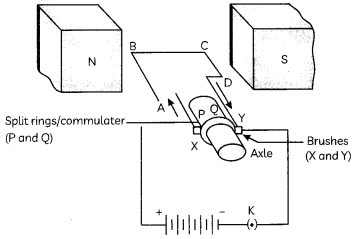Electric Motor
Electric motor is a device that converts electric energy to mechanical energy and is used as an important component in electric fans, washing machines etc.
Principle of Working of an Electric Motor
The electric motor works on the principle of force experienced by a current carrying conductor in the form of coil of wire when placed between the two poles of the magnetic field. The direction of force is given by Fleming’s Left Hand Rule.
Main Components of Electric Motor

Coil of wire: A coil of wire is wrapped around an axle and placed in the magnetic field.
Sliding contacts: These are meant to maintain contact between the split ring commutator and the coil.
Split ring commutator: Its function is to reverse the direction of current in the loop after every half a rotation so that the coil rotates continuously in the same direction.
Working of an Electric Motor
Current in the coil ABCD enters from the source battery through conducting brush X and flows back to the battery through brush Y. The current in arm AB of the coil flows from A to B and from C to D in arm CD. On applying Fleming’s left-hand rule for the direction of force on a current-carrying conductor in a magnetic field, we find that the forceacting on arm AB pushes it downwards while the force acting on arm CD pushes it upwards. At half rotation, Q makes contact with the brush X and P with brush Y. Therefore the current in the coil gets reversed and flows along the path DCBA.
Commercial motors: The commercial motors use:
- an electromagnet in place of permanent magnet;
- large number of turns of the conducting wire in the current-carrying coil
- A soft iron core on which the coil is wound.
The soft iron core, on which the coil is wound, plus the coils, is called an armature. This enhances the power of the motor.
Uses of Electric Motor
- These are used in electric fans.
- Used for pumping water.
- Big DC motors are used for running tram cars.
- Small DC motors are used in various toys.